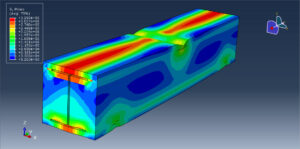In this tutorial, the Fire analysis of a Steel-Timber composite beam in Abaqus has been done. Both steel and timber wood beams are modeled as three-dimensional solid parts. You can see a figure of the assembled parts below

The combination of timber and steel in a single-beam cross-section can result in multiple benefits. There are a lot of ways to do so, but have shown that one type of configuration is of particular interest: it consists of fitting timber beams between the flanges of a H-shaped steel section. Studies suggest that these STC (Steel–steel-timber composite) beams allow mutual mechanical reinforcement of both steel and timber components. They show improved strength compared to steel-only or timber-only beams of the same size, as well as better ductility. It has also been found that the buckling of steel profiles is significantly reduced when combined with timber beams. propose various recommendations such as ensuring that the steel structure is fully enclosed in the timber. The timber is firmly secured in place, and the timber is seasoned to limit or prevent shrinkage and cracking, which could reduce the ability of the timber to control heat transfer to the structure. From a mechanical point of view at ambient temperature, the timber can improve resistance to the instability of steel beams.
In this tutorial, first fire analysis as a heat transfer step with conduction, convection, and radiation as the heat transfer method is done, then the results of it are imported to the structural model as a static bending test by using a predefined field. In the static approach, both temperature and mechanical load are considered
After the simulation, all results such as fire temperature, stress, strain AC yield, force-displacement diagram, and others are available. You can see some figures of the results below








 Abaqus tutorials Abaqus tutorials
Abaqus tutorials Abaqus tutorials




